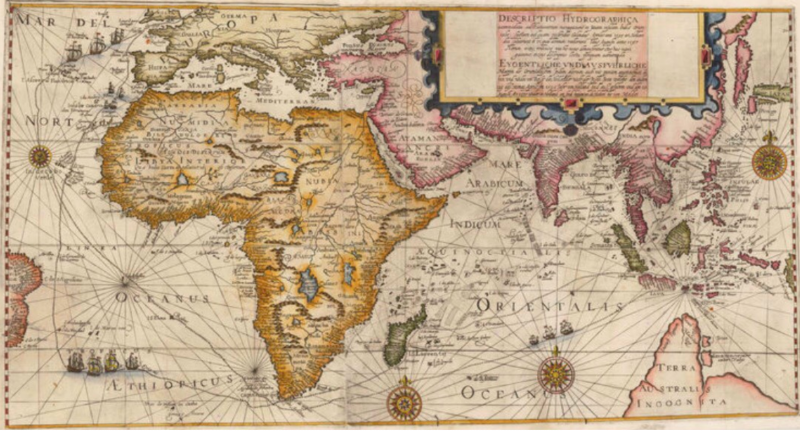The last decade of the sixteenth century heralded the emergence of the Dutch as the colonial power that was to supersede Portugal as the premier trading nation in Asia.
They established a tyrannical hold on the East Indian Islands and trade routes for the next 350 years. Dutch navigators, already familiar with the waters of the North Sea and the Baltic, probed in vain for a northern route to the Far East that would circumvent the Spanish and Portuguese fleets who tirelessly patrolled their trade routes, but the passage could not be found.
In desperation, the Dutch fought their way to the Spice Islands and Southeast Asia by way of the African coastline and the Cape of Good Hope. This period of Dutch dominance began with the exploratory voyages of Cornelis de Houtman to Bantam, a northwestern port in Java.
A rare antique map showing the outbound and return routes of de Houtman’s pioneering voyage to the East Indies between April 1595 and August 1597, the map covers the whole route from Amsterdam to Java and back.
In 1592 Cornelis de Houtman was sent by Amsterdam merchants to Lisbon for four years to conduct as much research as possible on the Spice Islands. During this time he acquired 25 manuscript charts by the Portuguese cartographer Bartolomeu Lasso that provided detailed information on the region. When he returned to the Netherlands he brought with him precious information about the seas and lands of the East, and details about the strengths and weaknesses of the Portuguese. De Houtman determined that Bantam (Banten) provided the best opportunity to buy spices.
In 1594 the Dutch Compagnie van Verre (i.e. the Long-Distance Company) was founded, and on April 2, 1595, four ships with 249 men left Amsterdam in search of the Spice Islands. The voyage was beset with trouble from the start, and scurvy broke out after only a few weeks due to insufficient provisions. They stopped briefly in Madagascar, and seventy people were laid to rest. On June 27, 1596, the ships finally arrived at Banten, Java. The information taken from the Portuguese directed the Dutch sailors to avoid the Malacca Strait–which was controlled by the Portuguese–and to sail through the Sunda Strait between Java and Sumatra.
In Java, de Houtman was introduced to the Sultan of Banten who promptly entered into an optimistic treaty with the Dutch, writing: “We are well content to have a permanent league of alliance and friendship with His Highness Prince Maurice of Nassau, of the Netherlands and with you, gentlemen.” The local Portuguese traders became very suspicious when de Houtman did not buy any black pepper and wanted to wait for the next harvest. Unfortunately, de Houtman was also undiplomatic and insulting to the sultan and was turned away for “rude behaviour” without being able to purchase any spices.
The four ships in de Houtman’s fleet sailed north of Java back to the Sunda Strait after circumnavigating Madura Island.
The Dutch ships then sailed east to Madura and were attacked by pirates along the way. Once there they were received without incident, but de Houtman ordered his men to brutally attack the civilian population in revenge for the piracy which was unrelated.
The ships then sailed for Bali, where they met with the island’s king in February 1597 and managed to obtain a few pots of pepper. At Bawean, an island north of East Java, one of the ships was purposely set on fire, and the remaining crew were incorporated into the other three ships. Near exhaustion, the crew decided not to go to the Moluccas as planned.
On their way back to Holland, The Dutch were prevented by Portuguese ships from taking on water and supplies at Saint Helena, the traditional island stop in the middle of the Atlantic Ocean to refresh supplies. Out of the 249 crew members that left two years earlier, only 87 returned, too weak to moor their ships themselves. Though the trip was a humanitarian disaster and financially unviable, it was a symbolic victory. Within five years, 65 more Dutch ships sailed east to trade. Soon, the Dutch would completely take over the spice trade in and around the Indian Ocean.
Collecting Antique Maps and Prints
Most map and print collectors, and investors, start by filling a blank wall at their home or office, and then as their knowledge and interest grow, they move on to collecting in earnest. We at Bartele Gallery are happy to introduce you to the world of antique maps and prints.
- Bartele Gallery Jakarta
- Mandarin Oriental Hotel
- Open Daily 11:00-20:00
- www.BarteleGallery.com




